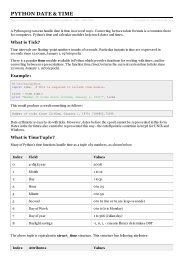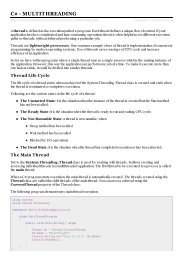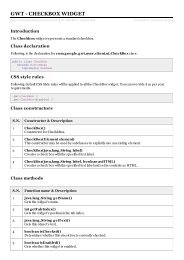download pascal tutorial (pdf - Tutorials Point
download pascal tutorial (pdf - Tutorials Point
download pascal tutorial (pdf - Tutorials Point
You also want an ePaper? Increase the reach of your titles
YUMPU automatically turns print PDFs into web optimized ePapers that Google loves.
program ex<strong>Point</strong>ers;<br />
const MAX = 3;<br />
var<br />
arr: array [1..MAX] of integer = (10, 100, 200);<br />
i: integer;<br />
iptr: ^integer;<br />
y: ^word;<br />
begin<br />
(* let us have array address in pointer *)<br />
iptr := @arr[MAX];<br />
for i := MAX downto 1 do<br />
begin<br />
y:= addr(iptr);<br />
writeln('Address of arr[', i, '] = ' , y^ );<br />
writeln(' Value of arr[', i, '] = ' , iptr^ );<br />
(* move to the next location *)<br />
dec(iptr);<br />
end;<br />
end.<br />
When the above code is compiled and executed, it produces the following result:<br />
Address of arr[3] = 32884<br />
Value of arrr[3] = 200<br />
Address of arr[2] = 32882<br />
Value of arr[2] = 100<br />
Address of arr[1] = 32880<br />
Value of arr[1] = 10<br />
<strong>Point</strong>er Comparisons<br />
<strong>Point</strong>ers may be compared by using relational operators, such as =, . If p1 and<br />
p2 point to variables that are related to each other, such as elements of the same array,<br />
then p1 and p2 can be meaningfully compared.<br />
The following program modifies the previous example one by incrementing the variable<br />
pointer so long as the address to which it points is either less than or equal to the address<br />
of the last element of the array, which is @arr[MAX]:<br />
TUTORIALS POINT<br />
Simply Easy Learning Page 95
















